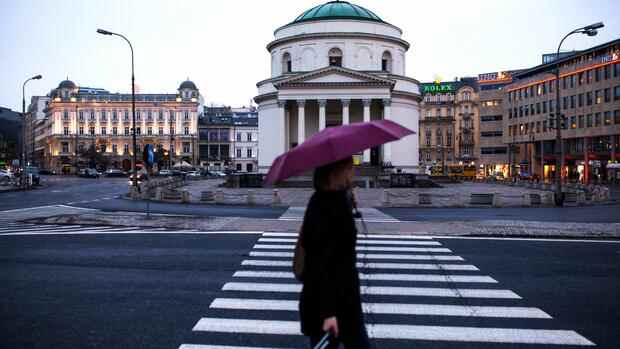The Polish economy is growing strongly.
(Photo: Bloomberg / Getty Images)
Vienna Old-school monetary politicians should enjoy Central Europe’s central bankers. While the US Federal Reserve is tightening its monetary policy at most a bit and the European Central Bank (ECB) is still hesitating, the Central Europeans have already taken action: Various central banks in the region have raised their key interest rates and made it clear that these were probably just the first steps .
The region’s central bankers were startled by the high inflation. The rate of inflation is highest in Poland, reaching 6.8 percent in October. Three weeks ago, the country’s central bank therefore raised its key interest rate somewhat surprisingly. On Wednesday, she raised the rate again – from 0.5 percent to 1.25 percent.
In doing so, it succeeds the central banks of Hungary and the Czech Republic, which were the first in the EU to turn monetary policy around in June. The Czech central bank took a bold step when it raised the key interest rate by 75 basis points to 1.5 percent at the end of September. This was the largest increase in 24 years, but it didn’t stop there. On Thursday, the central bank increased the rate by a further 125 basis points to 2.75 percent. Hardly any economist had expected such an increase.
With the latest measure, the central bank wants to ensure that inflation falls back in the direction of its medium-term inflation target of two percent. In addition, the aim is to prevent a wage-price spiral that arises when both factors swing each other up. This can happen, for example, if the collective bargaining parties assume higher inflation and accordingly agree higher wages.
Top jobs of the day
Find the best jobs now and
be notified by email.
The central bankers in the region are not at a loss for clear statements. Those Czechs are currently speaking in a “combative tone”, write the economists of the Austrian bank Erste Group. Tomas Nidetzky, the deputy head of the Czech central bank, had said just a few days ago: “Unless anything unusual happens, we will raise the key rate to 2.5 to 3 percent.” Nidetzky believed that the high energy prices would possibly fall again; nevertheless, the risk of further price increases is high. The central banker addressed the boom in the domestic real estate market and the upward pressure on wages. At 2.8 percent, the Czech Republic has the lowest unemployment rate in Europe.
The monetary policy council of Hungary’s central bank is also concerned. One of the members recently said that the period of higher inflation rates is likely to be longer than anticipated.
The countries of Central Europe are booming, in some ways they are better off than the Western European countries. This applies not only to the astonishingly low unemployment rate in the Czech Republic, but also to Poland’s stable development. In the second quarter of 2021, the country’s economy grew by 10.7 percent. The value is particularly noteworthy because the Polish economy collapsed less severely during the pandemic. In other countries where, for example, tourism plays a major role, the economy contracted much more sharply. The comparative values from last year are therefore particularly low there and the growth rates are now correspondingly high. In Poland, on the other hand, the economy only shrank by 2.5 percent in the 2020 pandemic. The country owes this to an advantageous mix of industries: the battered tourism sector is only of minor importance; on the other hand, industry and the IT sector, which have been little affected by the pandemic, are strong.
Tightening monetary policy harbors risks
However, the tighter monetary policy of the central European central banks is not entirely risk-free, because the outlook has deteriorated somewhat again in the region. This has to do with rising energy prices and the problems of the auto industry. The German manufacturers are particularly well represented with factories in Hungary and the Czech Republic. And these recently had to cut their production, partly because semiconductors are scarce.
Only the next few months will tell whether the central bankers in Central Europe tightened their monetary policy too early. The economic figures are still difficult to interpret due to the catch-up effects caused by the pandemic and other distortions.
First of all, economists expect inflation to continue to rise. Jiri Rusnok, the head of the Czech central bank, predicts that inflation will rise to seven percent in winter. And in the case of Poland, Erste Group analysts expect inflation to peak at the end of the year. They forecast eight percent. It also says: “Even a higher value cannot be ruled out.”
More: The Fed heralds the turnaround in monetary policy
